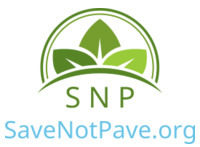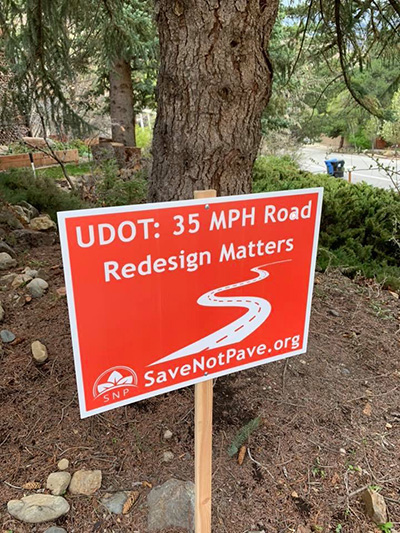The CWC (Central Wasatch Commission) closed its public comment period. Attached is the letter submitted by Save Not Pave for their consideration related to their Mountainland Transportation System https://cwc.utah.gov/transportation/
SNP Recommendation to CWC for Mountainland Transportation System
Save Not Pave is a 600-member non-partisan, community coalition based in Cottonwood Heights working with other like-minded organizations toward logical transportation and land use solutions for Utah’s growing population.
For community safety & health, we seek a regional, year round, Express transit plan for SL valley residents, recreationalists & commuters, and to have Cottonwood Heights’ stretch of Wasatch Blvd treated by UDOT as a “street” (narrow lanes, wider bike/sidewalks, crosswalks, slow speed) not a “road” (high speed travel to get from one spot to another spot).
An immediate imperative we see is the need for UDOT to be held to the NEPA process. That is, according to NEPA, UDOT must thoroughly screen all comments which meet their criteria: “provide an integrated transportation system that improves the reliability, mobility and safety for all users on SR 210 from Ft Union Blvd through the town of Alta.” This must include comments that stress a regionalized plan serving local communities in and around SR 210, instead of UDOT’s current focus on road reliability for local & out-of-state skiers and north/south commuters.
Like CWC’s stakeholder componentry, SNP is a galvanized group of stakeholders, concerned citizens, with every vested interest in a revised transportation system that supports our highly mobile lifestyles. To protect our neighborhoods from the urban blight associated with widening neighborhood streets into fast moving, dangerous and polluting car-based arterials, Save Not Pave is demanding logical, long term, financially sound solutions to address growing needs of tax-paying residents, as well as commuters, bicyclists, runners, hikers, climbers and skiers, both local and visiting, within our foothill corridor.
Thoughtful public comment has been collected on this issue for decades. The voice is clear for transit and active transportation. The two dove-tail together to protect public health and safety. More lanes, high speeds and parking lots induce traffic-causing bottlenecking, as well as air, noise and light pollution for the communities they penetrate.
With no holistic vision for SL Valley development, the race to monetize – build, build, build — is more fierce than ever. The Wasatch Front is looking at the air quality disaster that removing more vegetation, replacing it with huge concrete and asphalted airport, prison, inland port and The Point projects will bring. The further insult of adding vehicular lanes and parking lots to induce more traffic is the final nail in the air quality coffin should Salt Lake County, WFRC and the CWC go down that path.
Dr. Brian Muench of Utah Physicians for a Healthy Environment documents scientifically that air pollution in all its forms harms all people, even fetuses, not just “sensitive persons” when breathed in even smallest amounts. Respiratory, neurological, immune bodily systems are permanently compromised as the air we breathe worsens.
More than ever the argument arises, as we assault the natural balance with urban sprawl and antiquated building zeal, the Wasatch Front and Back need a masterful regionalized transportation plan that improves air quality by getting more cars off our roads and turning our tax dollars to fund UTA not UDOT. We need meaningful transit for citizens, commuters and recreationalists not just visiting skiers as the state legislature would have it.
Plans need specificity. Whether the Kem C. Gardner Institute Utah Roadmap or WFRC’s Wasatch Choice 2050, these plans are nebulous and lacking when it comes to addressing specific challenges of mobility for the citizens within each city along SL Valley’s east side as well as effectively moving east-sidecommuters and recreationalists.
Save Not Pave’s recommendations to CWC:
- Funding. At the core of the Mountainland Transportation System needs to be the brutal honesty that the Utah Legislature through WFRC funds car-centric transportation with 75% of taxpayer dollars and only 25% of these funds spent on transit/active transportation. Reverse that model. Fund transit and active transportation!
- Transit north/south for eastern SL Valley. UTA’s current “Express Bus” commuter system is flawed and inadequate. Many of our Save Not Pave members who work in Research Park and the University of Utah indicate that they would ride transit if it were designed and executed in a viable way. Commuters within eastern Draper and Sandy should have a collector point such as 9800 South Highland; Cottonwood Heights: 6200 South Park & Ride; Holladay and Millcreek: TBA, etc. Every ten minutes, M-F, during the first peak morning rush hour an Express Bus loads and leaves. It travels non-stop utilizing I-215 until reaching Research Park, University of Utah and downtown SLC. Likewise, in the other direction leaving between 4:45-6pm.
- Transit east/west. UTA’s fleet should slowly over the years change to a mix including smaller “shuttle” vans that would be numerous, frequent and free. Key east/west rail or tunneling system from existing 9400 South and 7000 South Light Rail or Frontrunner stations connecting to Alta, Snowbird, Solitude, Brighton Express Buses during the peak weekends throughout the year as well as smaller, free and frequent trail head shuttles utilizing 10-seat vans or the equivalent leave from canyon mouth intermodal hubs sans parking lots. Again: frequent and free.
- Shuttles. Replace parking lots with shuttle service. Over time, utilizing deliberate public awareness campaigns and interlocal agreements between city/county/UTA, a shuttling plan within each east-side city should phase in.
- Public Awareness Campaign. Citizens’ understanding of incorporating active transportation and transit into their everyday lives needs to be part of the Mountainland Transportation Initiative. This campaign should be an inter-local effort emphasizing tax savings, convenience, community camaraderie, daily exercise of active transportation, health, and safety. Local businesses, elected representatives and school districts should lead young and old toward new, more safe and healthful lifestyle choices by entering into a unified campaign.
For example: a person in West Valley or Murray gets up in the morning and thinks: “I want to go hiking today.” That thought develops to ‘I could go on a walk within my neighborhood to a nearby park or, alternatively, I could walk or ride my bike to the shuttle system that would drop me off at a trailhead.’ Rome wasn’t built in a day but with recent natural challenges of Covid, earthquakes, and forest fires Utahans can evolve. Leadership mixed with a little coaxing goes a long way!
- Aesthetics. No longer dreaded by the few that currently utilize buses, the system needs to include shade by summer, warmth by winter, restrooms, pleasing visuals.
- Technological app. Vehicular real-time communication through a comprehensive app giving drivers information on currently available and projected availability for best route, parking and shuttles related to recreation opportunities summer, fall, winter, and spring (i.e. for trailheads, resorts).
- Wasatch Front & Back. I-80 already exists as the thorough-fare. One of those lanes in each direction should be converted to either Express Bus or rail offering free and frequent transit for commuters and recreational users.
- Fleet Management. Diversify UTA fleet over time. Phase out emphasis on large buses (except enough needed for rush hour) and phase in 10-15 seat vans that are agile and non-carbon emitting providing service that can make more numerous on-demand stops, frequent and free. Instead of spending tax dollars on UDOT acquiring property, asphalting and maintaining more roadways, Utahans benefit from less expenditures for their own private vehicles as they utilize viable transit, and the system creates employment opportunity within UTA as drivers, engineers, managers, etc. need is heightened.
The time has come. The train is leaving the station. Let’s be on it, and each bring ten of our best friends!
Respectfully submitted,


